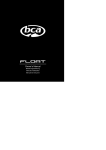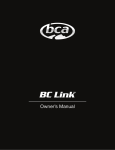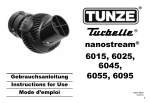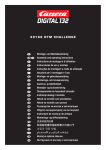Download bca FLOAT Owner`s manual
Transcript
Owner’s Manual
Bedienungsanleitung
Manuel D’Utilisation
Manuale Di Istruzioni
Float 22
Basic Components
airbag
trigger handle
leg strap
2
10
waist belt
12
13
Float 22
Basic Components
probe and shovel
compartment
airbag compartment
diagonal ski mount loop
main storage compartment
helmet carry
loops
diagonal ski mount loop
11
waist belt pocket
3
Float Throttle
Basic Components
airbag
13
trigger handle
leg strap
waist belt
4
12
10
Float Throttle
Basic Components
probe and shovel
compartment
airbag compartment
helmet carry
loops
main storage compartment
THROTTL
E
11
waist belt pocket
5
Float 32
Basic Components
airbag
load lifters
13
trigger handle: can be
set on either shoulder,
hydration on the opposite
trigger handle: can be
set on either shoulder,
hydration on the opposite
waist belt
leg strap
6
10
13
12
Float 32
Basic Components
airbag compartment
lined goggle pocket
diagonal ski mount loop
shovel and probe
compartment
helmet sling storage
helmet carry
loops
ice axe cords
compression strap
main storage
compartment
ice axe loops
diagonal ski mount loop
12
waist belt pocket
7
Theory of Operation / Disclaimer / Warranty
Why do I need an avalanche airbag?
Preventing or minimizing burial depth is the key to reducing avalanche fatalities. That’s because the
majority of time in an avalanche rescue is spent on excavating the victim. An airbag is designed to
keep you at or near the surface, minimizing excavation time.
Disclaimer
The Float system is designed to help improve your chances of surviving an avalanche. It must be used
correctly, following the guidelines in this manual. Perform a practice deployment at least once a year.
Do not modify any aspect of this product or perform any operations not described in this manual.
Your Float cannot prevent the release of an avalanche or guarantee survival under any conditions.
While it will provide some protection from impact, no airbag system can completely prevent injury
from trauma. Any airbag must be used in conjunction with a beacon, shovel, probe, and helmet to
provide the best chance of survival. As with other avalanche rescue tools, your airbag should not
promote taking more risks.
You have invested in lifesaving technology. Be sure you have also invested your time in acquiring
the necessary skills to avoid avalanche situations before heading into the backcountry. Take an
avalanche safety course, practice with your equipment, and plan your route according to the regional
avalanche forecast.
Warranty
The manufacturer, Backcountry Access, Inc. (BCA), expressly warrants the workmanship and
components of this product for three years after the date of retail purchase. All parts will be either
repaired or replaced free of charge, including labor, by the manufacturer. This warranty does not cover
damage to the product caused by improper use or excessive wear and tear. Direct all warranty claims
to BCA or your retailer. All claims must include proof of purchase and a return authorization number.
To ensure warranty protection and periodic technical updates please register online at:
www.backcountryaccess.com/warranty .
8
Equipment Check
Compressed Air System
trigger cover
7
trigger cable
pressure gauge
8
4
14
release valve cover
coupler gauge
air hose
ejector assembly
9
air cylinder
1
3
quick
connect fitting
2
9
Installing Compressed Air Cylinder
1. Remove packaging caps from compressed air cylinder. To reach the trigger cable and air hose,
unzip the main storage compartment and fold back the Velcro flap inside.
2. With the compressed air cylinder outside of the backpack’s cylinder sleeve, connect the quick
connect fitting on the air hose u by pulling the large ring toward the air cylinder v. It should click
back into place when air hose w is properly connected. Coupler gauge x should fit in place to
ensure air hose is connected properly.
4
1
1
4
WRONG
SECURE
1
1
3. IMPORTANT! Screw the trigger cable nut y onto the trigger pin z. To expose the trigger
cable nut before threading it onto the trigger pin, it might be necessary to push the trigger handle
upwards.
4. Screw the trigger cover { over the trigger cable nut y.
5
6
7
TRIGGER CABLE NUT ATTACHED
5
7
TRIGGER COVER ATTACHED
7
10
Using the Avalanche Airbag
5. After all connections have been checked, slide the compressed air cylinder into the backpack’s
cylinder sleeve.
6. Empty cylinders should only be refilled or exchanged at authorized Float refill or exchange centers.
For a list of these locations, please see www.backcountryaccess.com/refillcenters. If shipping is
required, see “Shipping a Compressed Air Cylinder” below.
7. To disconnect an empty cylinder, follow the above steps in reverse.
Equipment Check
System Fittings
Follow the previous “Installing Compressed Air Cylinder” steps to verify connections are correct.
Every time you use your Float system, verify the trigger cable nut connection by unscrewing the
trigger cover { and making sure the trigger cable nut y is attached securely to the trigger pin z.
Replace trigger cover.
Air Cylinder
Check the pressure gauge | on the compressed air cylinder and make sure it is between 2500
and 2700 psi (172 to 186 bar) at room temperature (approximately 70°F or 21°C). Pressure must
be checked at room temperature for the reading to be accurate. Check pressure before every use.
PRESSURE MUST BE IN THIS RANGE OR THE SYSTEM MAY NOT FUNCTION PROPERLY.
Once the system is exposed to cold, the pressure will drop. If the pressure is ever observed below
2000 psi (138 bar), at any temperature, the airbag may not fill completely. See “Installing Compressed
Air Cylinder” on page 10 for replacement details.Inspect the cylinder. Do not use a cylinder that is
dented or damaged.
Pack
Make sure the Velcro flap on the top of the
airbag compartment is securely fastened.
This will ensure that the airbag
is completely stored and secure.
WRONG
SECURE
Only the airbag and ejector are meant to be
stored in the airbag compartment. Do not store any additional items in this compartment.
Check that nothing is loose inside the compressed air system or blocking the ejector assembly
Make sure the compartment is zipped completely shut.
9
.
11
Using the Avalanche Airbag
Check to make sure that nothing is obstructing the airbag compartment on the outside of the pack,
especially any items with sharp points such as crampons or ice tools. Only carry skis using the
diagonal ski carry. Do not use the side compression straps for A-frame carry, as they may obstruct the
airbag’s deployment.
Pack Adjustments
Your pack should be properly fitted before you head into avalanche terrain. The forces
of an avalanche can rip the pack from your back if it is not secured to your body.
Attaching Leg Strap
The leg strap 10 can be found in the waist belt pocket 11 . It should be used to
prevent the pack from being pulled off in an avalanche. Remove the leg strap from
the waist belt pocket. Thread one of the waist buckle pieces 12 through one end
of the leg strap. Wrap the other end of the leg strap behind you and pull it forward
between your legs. Insert the same waist buckle piece through the loose end of the
leg strap and fasten the waist buckle. Tighten the adjustment until it is snug but comfortable.
10
11
Waist Buckle 12
12
There are two parts to the buckle: male and female. Insert the male part into the widest opening of the
female part. Tighten the waist strap until snug. When attached correctly, the webbing and the buckle
should lay flat against your body.
Shovel and Probe Storage
Store shovel blade, shovel handle and probe in designated pockets, located in the external tool
compartment.
12
Using the Avalanche Airbag
Ski/Snowboard Attachment
Float 22: Skis can be carried using the diagonal ski mounts. To carry a snowboard, order our BCA
Snowboard Carry Attachment, which integrates with the snowboard attachment loops on the back panel.
Float Throttle: Does not offer the diagonal ski carry. However, it is possible to attach BCA’s Snowboard
Carry Attachment, which integrates with the snowboard attachment loops on the back panel.
Float 32: Skis can be carried using the diagonal ski mounts. To carry a snowboard, order our BCA
Snowboard Carry Attachment, which integrates with the snowboard attachment loops on the back panel.
Hydration (reservoir not included)
Float 22 and Float Throttle: Not compatible with hydration system.
Float 32: Place reservoir in main compartment. Feed hydration tube through the corner opening (a)
on the opposite side of where the trigger cable enters the main compartment. Open airbag
compartment and unfold airbag. Route the hydration tube through the airbag compartment and into
the shoulder strap opening (b) that does not contain the airbag trigger. Before repacking airbag,
make sure the hydration tube is threaded under the airbag and ejector assembly to eliminate any
obstruction during deployment.
b
b
a
Helmet Carrying
Float 22: The mesh helmet sling attaches to the four loops on the front of the pack.
Float Throttle: Helmet sling is not included, but pack contains helmet carry loops compatible with the
helmet sling included with other models.
Float 32: Helmet sling is permanently fixed on the front of the pack and is integrated into
the sling storage compartment under the BCA logo. Pull out the sling and attach clips to
lower two loops, or upper two loops if using the diagonal ski carry option.
Deployment
When traveling in avalanche terrain, unzip the pocket where the trigger handle
13 is stored (see image on right). In case of an avalanche, pull the trigger handle
quickly in a downward motion, reaching across your body with the hand opposite
the trigger. Try skiing or riding to the flanks of the avalanche to escape the debris. 13
When the avalanche slows down, preserve your airway by covering your mouth
with your hand or elbow.
13
Using the Avalanche Airbag
What to Expect
The airbag should exit the backpack and fill completely in approximately three seconds. The airbag
will continue to build pressure for a few seconds longer until the system pressure equalizes. The
airbag will hold air for several minutes until the threat of an avalanche has passed.
After Deployment
Release the air from the airbag by pressing the release valve with your finger. The valve is located
underneath the orange release valve cover 14 . Do not use hard or sharp objects to hold the release
valve open, as they could damage the valve-sealing surface. Re-pack the airbag into the airbag
compartment. See “Packing the Airbag” below for details.
The Float airbag will not deploy again until the cylinder is refilled or replaced. This can be done at a
Float Refill Center (see www.backcountryaccess.com/refillcenters). To install the charged cylinder,
see “Installing Compressed Air Cylinder” on page 10. If you have deployed your airbag in an
avalanche, please contact BCA for a free airbag inspection and cylinder refill.
Packing the Airbag
The airbag must be folded into the airbag compartment. DO NOT ROLL OR STUFF THE AIRBAG OR
THE SYSTEM MAY NOT DEPLOY PROPERLY. If the airbag is wet, dry it completely before packing.
Empty any residual air from the airbag using the release valve (you may need to do this periodically as you
pack the bag). It is very important that all residual air has been released. After this air has been released,
disconnect the air hose from the cylinder before folding the airbag.
1. Completely separate the zipper so the slider is only attached to one set of teeth.
2. Bring zipper slider back to the opposite side of pack where the zipper
begins (a).
3. Begin by laying out the deflated airbag flat on the ground. Make one
vertical accordion fold on each side of the airbag (b).
a)
4. Next make two horizontal accordion folds on the airbag (c). After this step
your airbag is ready to be zipped inside the airbag compartment.
5. With airbag folded inside the compartment, re-engage the zipper (d)
and zip the compartment past the Velcro flap at the top of the compartment (e). Fasten Velcro and finish
zipping the compartment closed (f).
6. Refill or exchange your empty cylinder before using your Float pack again.
e)
b)
c)
f)
14
d)
Maintenance
Removing and Installing the Airbag System
The 12/13 Float packs feature a removable and interchangeable airbag system. The airbag
components can be swapped between the Float 32 and Float 22/Float Throttle or removed entirely.
Removing
1. To remove the airbag, open the airbag compartment by pulling the breakaway zipper apart under
the Velcro flap. Never try to “unzip” the airbag compartment zipper. Doing so could result in damage
to the breakaway zipper.
2. Disconnect the trigger cable and air hose from the cylinder (a).
3. Unfasten the black Velcro holding the loose end of the orange rope in place. Un-thread the rope
from the webbing loops (b).
4. Once the rope is no longer threaded through the webbing loops, the airbag, ejector, trigger cable and
air hose are free to remove (c). The trigger cable stays with pack, but can be removed as noted later in
the section “Moving the Trigger.”
a
b
c
15
Installing
1. With the airbag unfolded, lay the ejector in the airbag compartment with the orange release valve
cover facing up (a). The air hose should be fed through the designated opening (b) into the main
storage compartment where the cylinder is kept.
2. Starting on the side with the fixed end of the orange rope, thread the rope downward through the
first slit in the airbag. Thread the rope through the first webbing loop then upward back through the
first slit. Repeat this step with each slit (c) until you reach the ejector tube.
3. Once the threading is complete up to the ejector tube, pull the rope tight. This action will pull the
webbing loops up through the attachment slits in the airbag.
4. Bring rope over ejector tube.
5. Repeat threading technique through remaining slits and webbing loops.
6. Secure the loose end of the orange rope by running it up through the black Velcro loop, then loop
it back down and fold the Velcro flap over it.
7. Repack airbag and close compartment (see above instructions for repacking).
8. Reconnect trigger cable and air hose to cylinder (d).
a
b
c
d
16
Installing / Maintenance and Storage
Moving the Trigger
The Float 32 allows you to install the trigger in the left or right shoulder strap, depending on your
preference. This feature is not available in the Float 22 or Float Throttle.
Removing
1. Open the zipper on the shoulder strap containing the trigger.
2. Untighten the small screw that attaches the trigger to the webbing loop inside the shoulder strap.
3. Pull the trigger and cable out (a) through the shoulder strap zipper.
a
Installing
1. Starting at the shoulder strap zipper (a), thread the trigger cable, leading with the trigger cover,
back into the pack (b). Be sure the trigger cable is fed underneath the airbag components.
2. Feed trigger cable through the opening in bottom right corner of the airbag compartment (c) into
the main storage pocket that stores the cylinder.
3. Inside the shoulder strap zipper, secure the trigger cable by fastening the screw on the trigger
assembly to the webbing loop.
b
b
c
a
17
Maintenance / Storage / Transportation
No scheduled maintenance is required as long as the system is stored in a cool, dry place. Do not expose
a charged Float cylinder to temperatures exceeding 130°F (55°C) or below -22°F (-30°C). If subjected to
adverse conditions, check that all connections are free of contaminants. Pack can be cleaned with warm
soapy water and connections can be cleaned with a damp cloth. Do not use lubricants.
Periodic Deployment
BCA recommends deploying your Float airbag at least once per year, both to make sure the system is
operating correctly and to be sure the user knows how to operate the equipment efficiently. Put it on, pull
the trigger, repack the airbag and refill the cylinder before the season starts. Your Float airbag is designed
to undergo a minimum of 20 deployments and is warranted for three years. With proper care, it should last
five years or more.
Discharging Compressed Air Cylinder
If the compressed air cylinder v is pressurized but the pressure is below 2500 psi (172 bar) at 70°F
(21°C), it should not be used in the backcountry, but it may be used for a practice deployment. Simply
deploy the airbag by pulling on the trigger handle.
DO NOT POINT CYLINDER OUTLET PORT (COUPLER) AT ANYONE OR ANYTHING, AS IT
COULD CAUSE DAMAGE OR INJURY. DISCHARGING A COMPRESSED AIR CYLINDER IS
LOUD – PERSONAL EAR PROTECTION IS RECOMMENDED.
Shipping a Compressed Air Cylinder
DISCHARGE CYLINDER BEFORE SHIPPING.
Compressed air cylinders may not be shipped pressurized without proper (Hazmat) certification.
Empty or full compressed air cylinders must be shipped in original packaging to prevent damage.
Please return protective covers. When shipping unpressurized cylinders in their original packaging, please make sure you remove any Hazmat labels or markings that were used when they were
shipped pressurized.
Transportation Guidelines
While the International Air Transport Association (IATA) has specifically approved avalanche airbags
with pressurized cylinders for airline travel, the Transportation Security Administration (TSA) does
not allow them on flights to and from North America. If you are traveling in countries outside of North
America, contact your airline in advance for permission to check through your pressurized Float cylinder.
If permission is granted, then pack the pressurized cylinder in your checked baggage. Make sure it is
packed with the following document: www.backcountryaccess.com/IATAdoc .
If you are traveling to or from North America, then TSA will not allow your pressurized cylinder on board.
Discharge the compressed air cylinder before entering the airport. Once empty, unscrew the cylinder
head from the cylinder and put both in clean, re-sealable plastic bags. Carry them through the TSA
security checkpoint so they are visible to TSA personnel. Afterward, the cylinder head can be screwed
back on the cylinder by hand. When you reach your destination, locate a Float Refill Center and
exchange or refill your empty cylinder. For a list of Float refill/exchange locations, visit our site at
www.backcountryaccess.com/refillcenters .
18
Certifications and Markings
The following marks can be found on Backcountry Access Float avalanche airbags.
The CE mark of conformity indicates that Backcountry Access and this product meet the
requirements of the Personal Protective Equipment Directive (89/686/EEC).
The Pi mark of conformity indicates that Backcountry Access and this product meet the
requirements of ADR/RID and TPED (Directive 2010/35/EU).
Tested by TÜV SÜD: a globally recognized testing, inspection, and certification
organization.
TÜV Süd Product Service GmbH
Ridlerstr. 21
D-80339 Munich
Germany
EU representative:
BCA Europe
Davisstraße 11 b
A-5400 Hallein
Austria
Ph: 0043 (0) 6245 / 77385
Fax: 0043 (0) 6245 / 77385 - 99
Backcountry Access Float avalanche airbags are covered under U.S. patent: #7,878,141.
Float 22:
Pack volume: 22 l (1343 cu in)
Float Throttle:
Pack volume: 22 l (1343 cu in)
Float 32: Pack volume: 32 l (1953 cu in)
Weight: 5.5 pounds (2495 g), entire system including cylinder
Weight: 5.5 pounds (2495 g), entire system including cylinder
Weight: 6.4 pounds (2903 g), entire system including cylinder
Airbag volume: 150 liters
Cylinder/cylinder head: Weight: 385 g/206 g Volume: 290 ml
System: Tensile strength >3000 N Operating temperature range –30ºC to 55ºC (-22ºF to 130ºF)
19
Avalanche Rescue
This is a basic introduction to avalanche rescue techniques. On our website, you will also find a list of
avalanche instructors. We strongly suggest taking an avalanche course in your area before venturing
into the backcountry. Each person needs a working beacon, probe and shovel—and must know how
to use them. Before leaving, call your local avalanche forecast center and determine the danger level
in the area you intend to visit:
US: www.avalanche.org
Canada: www.avalanche.ca
Europe: www.lawinen.org
Searching for victims
If a member of your group is buried, you must perform a beacon
search. The objective is to find the strongest signal (lowest
distance reading) and immediately begin probing the area. In the
event of a burial, switch all avalanche beacons to search mode.
The guidelines below assume the use of a digital beacon.
20m
40m
path
40m
avalanche
Signal search: If there is a “last seen point,” start your signal
search there. Otherwise, start your signal search at the top,
bottom or side of the slide path. See diagram on right to establish
a search pattern.
20m
Coarse search: Once a signal is engaged, align your beacon so
that any of the center three lights are flashing and move quickly in
the direction it is pointing. Make sure the number in the distance
display is decreasing. If it is increasing, turn 180 degrees. Inside
ten meters, move slowly and try to keep the center search light engaged.
single searcher
search path
multiple searchers
search paths
Fine search: Within three meters, use your beacon as close as possible to the snow surface and look
for the smallest distance reading. Confirm by “bracketing” in the perpendicular direction.
Probing/Pinpointing: At the point where the distance has reached a
minimum, probe the area in concentric circles, with each probe hole about
10 inches (25cm) apart. Your probe should enter the snow perpendicular to
the slope. Once you have confirmed the victim’s location, leave the probe
in the snow.
90˚
Shoveling: While shoveling might seem elementary, it usually consumes
the majority of time during an avalanche beacon rescue. For best results,
start shoveling just downhill of the probe. Make your hole one “wingspan”
wide. In burials deeper than one meter, excavate downhill about 1.5
times the burial depth. For more advanced shoveling techniques,
see our website: www.backcountryaccess.com/shoveling .
1.5 x
burial depth
20
10˝ 10˝
25CM 25CM
Float save in Montezuma, Colorado, USA.
Backcountry Access, Inc.
2820 Wilderness Place, Unit H
Boulder, Colorado USA
Phone: 303.417.1345
www.backcountryaccess.com
BCA /K2 Europe
K2 Sports Europe GmbH
Seeshaupter Strasse 62
82377 Penzberg
Germany
Fon: +49 8856 901 – 0
[email protected]
































